Idea
One day my brother told me: "I am selling some electrical sit / stand desktops, but for most people they are too expensive, too big, and they love their existing office table that fits so nicely to the rest of their furniture and don’t want to change it. I am searching for a simple, inexpensive solution that you can place onto your desktop, without disturbing you and taking a big chunk of your place, a sort of tray where you can place your notebook or monitor, and that you can lift up and down quickly and easily."
After
months of examining the market, we found nothing suitable, and my
brother asked me if I as an engineer could come up with a solution. - I
accepted the challenge and for more than one year, I considered a vast
amount of different possible constructions and made hundreds of drafts: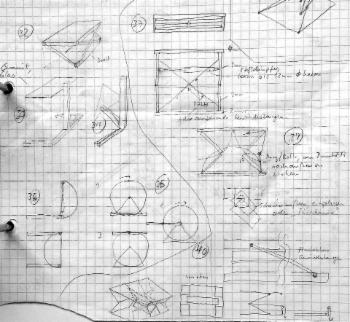
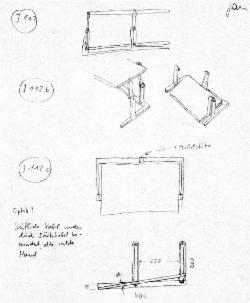
But none fulfilled all the needs of customers. Then one day I got the breakthrough idea to take a base plate and a work plate, both connected by two big hinges. One of them is rotated by 90 degrees to the other one mounted on a base plate. This forces the work plate to stay in parallel to the base plate. But, to get reasonable dimensions and a stable product, the first hinge must have a cut out where the second hinge can slide into when folding:
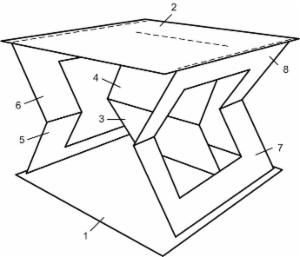
At first, I had strong doubts if this would work. And immediately I had the idea to have a third bracket in parallel to and opposing the first one, with also a cut out, to make it more stable. I made a simple paper model and was astonished how sturdy it was.
I could not imagine that no one else had had this idea, but it turned out to be true. So I decided to get patents for the idea. It took three years until all patents in Europe, USA and China were granted.
Height adjustment
The next question was how to lock and unlock the word plate in a certain height. In the beginning it seemed to be easy, but it wasn`t.
Then I found a solution where the hinge legs were automatically guided in a safe position:
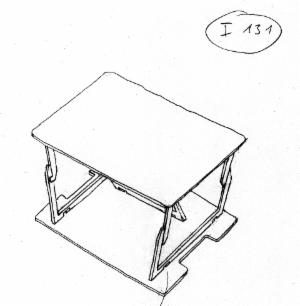
But with this principle the tray would have only one height when lifted. For a single person, it may be okay if he or she knows which height is necessary, but not for a mass product, or if different people work with it. So I searched to find a solution allowing several levels and again some weeks went by. Finally, a solution with two additional U-shaped stanchions (9 and 10) with different notches (12 and 13) was perfect to fulfill this need:
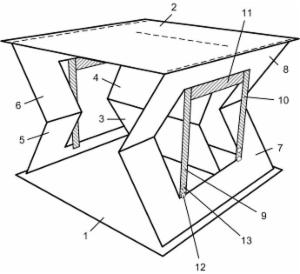
First model
To verify which design, functions and costs a good product would have, I constructed a model made of HPL, a hard and thin high pressure laminate which is, for instance, used for the coating of kitchen countertops. The parts of the model were connected by normal metallic piano hinges:
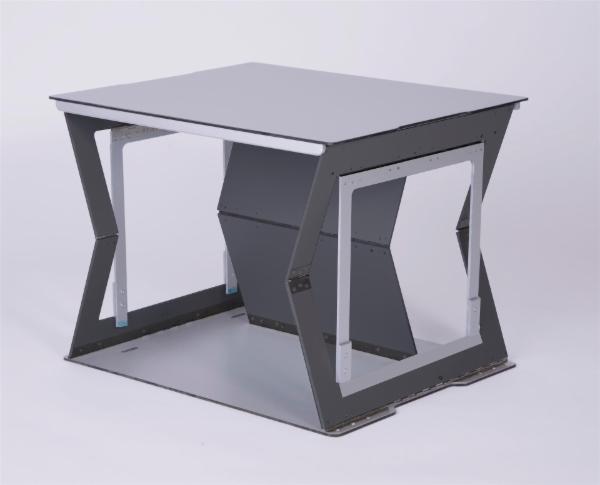
The model worked very well, much more stable then I had thought. No wobbling, no annoying yielding, so I immediately used this model for my monitor and keyboard.
But we wanted to know how other people would like the product. Therefore, we looked for a name. After thinking and discarding about hundred names we finally selected "Liftyfit".
We went to the iENA in Nuremberg, the world largest trade fair for "Ideas, Inventions, and New Products", and showed two different models of Liftyfit to the public. We also had a demonstration with a TV-moderator on stage and were broadcasted in a TV news program:
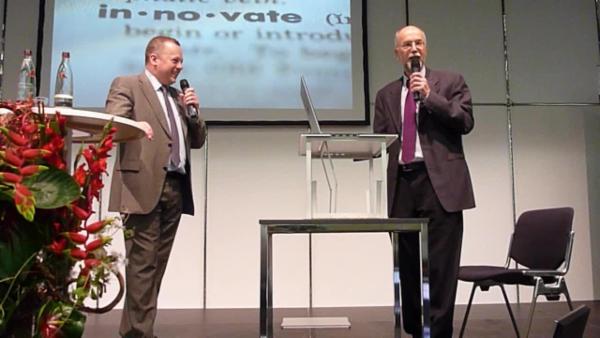
The feedback of the visitors was very encouraging. Some comments: "Almost everyone will use it!”, “Ingenious idea”, “Best product on the fair for me”, “Today I have not seen any good solution yet, until now”, and many more.
At the end, we won a price, a silver medal for Liftyfit!
Mass production
Aluminum
Our next step was to evaluate the costs for mass production. The first idea was to build Liftyfit from aluminum, because it is hard, flat and looks good. But cost quotations for the designed parts were by far too high. Also we feared the possibility that an electrically conducting work plate could cause problems in case of a possible damage of a cable or notebook placed on the platform.
Luckily the top managers of a laser cutting company were so excited about Liftyfit, that they gave the construction to their industry design office for further evaluation. And again, the heads of the industry design office were so convinced of Liftyfit that they decided to construct a 3D-model without upfront cost for us. According to them, only a construction for plastics injection casting can lead to an economically priced product.
Plastics injection molding
Some month later, in 2012, the first 3D model of Liftyfit was ready. We constructed a sturdy and easy to assemble solution for the hinges, but had a lot to do until the 3D model was in a state where we could make the first 1:1 model for one of the hinges which they made from ABS plastics on a 3D printer:
After another year of optimization we could start a complete 1:2 laser sintered model, which costs only a quarter of a 1:1 model. It had a base plate and a work plate made out of aluminum:
To find the right dimensions for Liftyfit for different persons, we made statistical investigations, where we took into account the variation of body proportions published for people living in Germany. We calculated the necessary heights so that with three different positions of the work plate it would fit people of almost all heights. And the width of the work plate would be sufficient for a 17" notebook and a mouse pad.
After further optimizations, we made a first 1:1 model directly from the CAD files of laser sintered polyamide. Only the base and the work plates were made of HPL, which we deemed as a good compromise between tooling cost and stability:
Composite, pretreated material
We asked for quotations for milling the HPL base and work plates, but after discussions with some manufacturers it turned out that milling would be rather expensive for a mass production, at least in Germany. Then we found manufacturers of trays for canteens. These are pressed out of a composite, pretreated material on rolls like a carpet roll. This material contains glass fibers and also binding and hardening agents and it gets very hard when pressed under high temperature and pressure. We made various experiments to verify this method, and are now confident that it is an excellent solution for the base and work plates.
The molding tools for this method are much cheaper than that for injection molding, but the CAD model of Liftyfit had to be adapted to that.
Next model
We let some people use the first 1:1 model of Liftyfit in their daily work. Thereafter we decided to modify some dimensions and details.
Then we made a market survey end of 2014, conducted by an organization among office employees, students and home office users in Germany. We showed the video on the Liftyfit home page how to lift it up and down and then put 10 questions. About 200 persons answered.
In total, 25 % of all answers said that Liftyfit
- would be an alternative for them and
- the measures of Liftyfit would be fine for them and
- the price of about 200 € would be reasonable for them (we didn`t ask for lower prices).
After that, we built another model which took into account all the feedback we got until now:
License
Now, as we got so much positive feedback and requests for buying Liftyfit, we would like to partner with a company that is also convinced of the great market chances and would like to produce and commercialize Liftyfit.